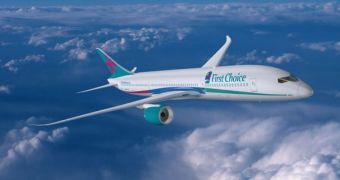This weekend, Boeing, the largest global aircraft manufacturer by revenue, the second largest by deliveries and the second-largest defense contractor in the world, will unveil the latest creation, the 787-9 Dreamliner, an environmentally friendly aircraft it hopes will revolutionize the industry of air travel.
It's not the first time the notion of "green" appears in the same sentence as "Boeing," the company having flirted with ecological applications for the past years. The aircraft industry giant was considering the possibility of installing a hydrogen-powered fuel cell which would provide backup power in aircrafts in emergency situations when the main power goes offline.
But the 787, programmed to enter active service in 2008, is more than that. The fuselage of the new jet is made entirely of composites, the skin and spars also made of composite material, only the ribs that give it the shape and resistance structure of the wing being made of aluminum. "By manufacturing a one-piece fuselage section, we are eliminating 1,500 aluminum sheets and 40,000 - 50,000 fasteners," Boeing said in a statement.
The airplane aims to become the middleweight champion, will offer up to 330 passenger seats and can fly long-haul routes while consuming up to 20 percent less fuel. This means that it will also produce fewer greenhouse gases, another sign of its ecological advantage. "In addition to bringing big-jet ranges to mid-size airplanes, the 787 will provide airlines with unmatched fuel efficiency, resulting in exceptional environmental performance," Boeing has said. "The airplane will use 20 percent less fuel for comparable missions than today's similarly sized airplane."
The first new model in 13 years, the 787 Dreamliner will perform a maiden test flight later this year and will enter commercial service with Japan's All Nippon Airways (ANA), next year. Hopefully, less fuel will also mean cheaper ticket prices.

 14 DAY TRIAL //
14 DAY TRIAL //